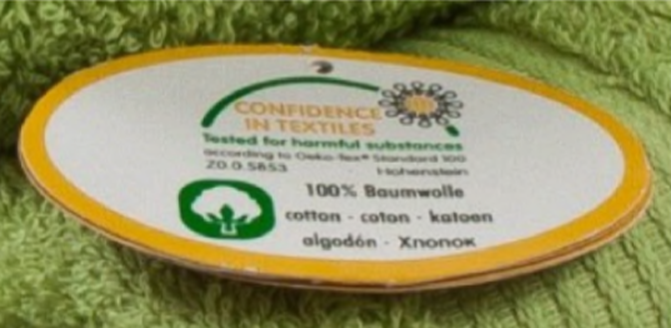Trademark protection for special quality? – Quality mark
The case: The renowned “Verein Bremer Baumwollbörse” (Bremen Cotton Exchange Association) has been promoting the interests of all enterprises involved in the processing and finishing of cotton and cotton products since 1872. In order to safeguard this activity by means of a quality mark, it registered the following Union trade mark for “woven fabrics and textile goods” and for “articles of clothing”: the well-known, so-called “International Cotton Mark”.

The association licenses this cotton mark to companies in the textile industry if they undertake to use the mark only for products made of new cotton fibres of good quality according to certain criteria. The association reserves the right to check the licensees’ compliance in terms of quality, and it does in fact regularly exercise this right of inspection, thus also monitoring production.
One day, however, a textile manufacturer used a very similar sign on a hangtag for towels without permission:

When the association filed a complaint in relation to this, the textile manufacturer defended itself by launching a cancellation attack, arguing that the association’s EU trade mark had never been used in a way that preserved its rights and therefore it ought to be cancelled.
It must be borne in mind that trade marks are an essential part of the system of undistorted competition that the Treaty on European Union seeks to establish and maintain. In order for an individual trade mark to fulfil its function in this system, it must offer a guarantee that all the goods or services bearing it have been manufactured or supplied under the control of a single undertaking which can be held responsible for their quality. The use of such a mark must also have the purpose of creating or maintaining an outlet for that undertaking for the goods or services.
These two conditions ensure that competition can indeed take place: first, the brand identifies and distinguishes the products or services of a particular company, which can therefore compete with other companies. Second, it ensures that the company in question actually uses the brand to actually compete.
A trade mark that is not used for products as an indication of a single company is not only functionless in this system; as a monopoly right, it also disrupts the system of undistorted competition! If the mark is not used to open up or maintain a sales market for the benefit of this company, there will be no competition element. In both cases, it must be cancelled and the monopoly right resulting from it eliminated.
But was the association’s trade mark really not being used as an indication of the manufacturer of the textiles? The association’s licensees had used the trade mark as a quality mark with the association’s consent, as follows:

In addition, the association had actually checked the quality of the textiles. However, in doing so, it had merely secured the quality of the goods and opened up a sales market for the textiles. This is not enough for the trade mark to fulfil its function in terms of undistorted competition. As shown above, the trade mark must also identify the company under whose control the goods were produced. Only then can it open up and/or maintain a sales market for this company. Competition does not take place between goods per se: only between named companies.
A trade mark can also guarantee the quality of the marked goods or services and inform customers about this quality: the so-called guarantee function. However, if this trade mark is to serve competition, it must at least at the same time also indicate the origin of these goods from a single company: the so-called origin function.
A trade mark that is only used as a quality mark does not identify a specific company, but rather disrupts the market. Consequently, the International Cotton Mark was cancelled,
Court of Justice of the European Union, 8 June 2017, C-689/15; OLG Düsseldorf, 30 November 2017, I-20 U 222/14.
Learnings: If you as a manufacturer or provider want to draw attention to the special quality of your products or services with your individual trade mark, you should make sure that your trade mark is not understood only as a quality mark. You can only obtain your trade mark in law if you ensure that the trade mark also refers to the manufacture and distribution of your products or the provision of your services from your company. This requires careful examination in each individual case. You should not shy away from the costs involved. In case of doubt, it is much more expensive if you lose your trade mark later. You should also carefully check before registering the trade mark whether it has the potential to be understood as a pure quality mark. For pure quality marks, the trade mark forms of a collective mark or a guarantee mark are suitable. However, these will not benefit your company alone.